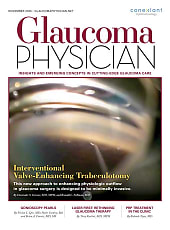With the development of MIGS, we have seen a variety of tools, stents, and techniques that provide significant IOP reduction with an excellent safety profile. That said, MIGS adoption has not been universal, with many high-volume cataract surgeons choosing not to adopt these procedures. Why not? Let’s look how this might play out.
Hyphema is a unique and salient risk of MIGS that may push some surgeons away. Is that reasonable? Hyphema usually occurs due to blood reflux from the canal, and it’s likely the most common adverse event to negatively impact the patient’s vision in the first week or month. While very rare exceptions could occur, the vast majority resolve on their own without consequence, and those that do require evacuation typically do not impact long-term outcomes. However, hyphemata are quite impactful to both the patient and doctor’s quality of life while present. Some of the most frustrated calls I have received from colleagues seeking advice have been related to hyphema management (and yes, you can use the word hyphemas, but hyphemata is acceptable and follows the Greek pluralization).
The reason hyphemata are so impactful is largely due to psychological factors, outlined beautifully by Kahneman and Tversky in their prospect theory.1 Prospect theory provides a framework for how people make decisions surrounding risk, and how a variety of cognitive biases about risk influence those choices. People tend to weigh short-term factors more heavily than long-term factors, an effect that they termed “proximity bias.” They also explain that the pain of a loss is weighed more heavily than the joy of an equivalent gain (loss aversion). We overweight small probabilities of loss and underweight near-certain gains.
Regret theory describes a phenomenon I am sure we all have witnessed.2 We act to avoid the most mentally available regret, regardless of its probability. We think only of our last undesirable patient outcome, not the 99 great ones prior to it. People tend to feel worse about errors of commission than they do about errors of omission. The worst implication that I can imagine regret theory having for the treatment of glaucoma would being a surgeon never operating and allowing patients to lose vision from glaucoma for fear of causing a smaller number of less impactful surgical complications.
With all of this in mind, I think some surgeons’ disinterest in adopting MIGS begins to make more sense. The rare, but early, vivid, minor complications are more salient to them than the long-term benefits.
There are ways for surgeons to recognize and reframe these risks.3 However, there may also be another solution. Interventional lasers and drug delivery tend not to have hyphema as a complication. Perhaps as we move toward more interventional therapies, we can approach the problem from both sides. Surgeons can recognize and reframe risks associated with surgical interventions, and innovators can work to refine procedures that limit these risks. Look at the article by Drs. Davinder Grover and Ron Fellman, as well as others in this issue of Glaucoma Physician, to learn more. GP
References
1. Kahneman D, Tversky A. Prospect theory: analysis of decision under risk. Econometrica. 1979;47:263-291.
2. Loomes G, Sugden R. Regret theory. Econ J. 1982;92:805-824.
3. Elwyn G, Frosch D, Thomson R, et al. Shared decision making: a model for clinical practice. J Gen Intern Med. 2012;27(10):1361-1367. doi:10.1007/s11606-012-2077-6









